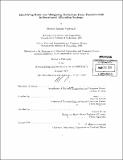| dc.contributor.advisor | Munther Dahleh and Andrew W. Lo. | en_US |
| dc.contributor.author | Valavanis, Stavros Athans | en_US |
| dc.contributor.other | Massachusetts Institute of Technology. Dept. of Electrical Engineering and Computer Science. | en_US |
| dc.date.accessioned | 2012-07-02T15:47:46Z | |
| dc.date.available | 2012-07-02T15:47:46Z | |
| dc.date.copyright | 2012 | en_US |
| dc.date.issued | 2012 | en_US |
| dc.identifier.uri | http://hdl.handle.net/1721.1/71493 | |
| dc.description | Thesis (Ph. D.)--Massachusetts Institute of Technology, Dept. of Electrical Engineering and Computer Science, 2012. | en_US |
| dc.description | Cataloged from PDF version of thesis. | en_US |
| dc.description | Includes bibliographical references (p. 154-157). | en_US |
| dc.description.abstract | The effects of the recent financial crisis have been devastating. Its causes are not well understood, but most people agree that incentive structures led to behaviors which are not captured by the standard theoretical paradigms of finance and economics. In this thesis, I analyze two models in which incentive structures cause deviations from such standard paradigms; one model focuses on the investment allocation process at the portfolio level and the other focuses on the investment allocation process at the financial system level. These two models are unified by the theme that incentive structures affect investment and risk in ways which are not captured by prevailing theoretical paradigms; my goal is to analyze these models so as to propose tools for identifying and/or mitigating their effects on risk and investment allocation. In analyzing the results of the asymmetric compensation incentive structure at the portfolio level, I propose a statistical inference tool which is able to decouple the information components of a portfolio allocation due to an equilibrium asset pricing model from the components due to the portfolio manager's proprietary views. Such information is useful for risk management purposes as it allows one to examine whether the portfolio manager has implemented "outrageous" views in his portfolio. To explore the effects of incentive structure at the financial system level, I analyze an agent based model of the financial system inspired by recent empirical evidence of levered financial intermediary procyclical balance sheet management practices and propose an optimal rate setting rule for the Federal Reserve which mitigates some of the undesired effects on investment allocation and risk which arises from the endogenous financial system agent interactions. | en_US |
| dc.description.statementofresponsibility | by Stavros Athans Valavanis. | en_US |
| dc.format.extent | 157 p. | en_US |
| dc.language.iso | eng | en_US |
| dc.publisher | Massachusetts Institute of Technology | en_US |
| dc.rights | M.I.T. theses are protected by
copyright. They may be viewed from this source for any purpose, but
reproduction or distribution in any format is prohibited without written
permission. See provided URL for inquiries about permission. | en_US |
| dc.rights.uri | http://dspace.mit.edu/handle/1721.1/7582 | en_US |
| dc.subject | Electrical Engineering and Computer Science. | en_US |
| dc.title | Identifying risks and mitigating deviations from fundamentals in investment allocation systems | en_US |
| dc.type | Thesis | en_US |
| dc.description.degree | Ph.D. | en_US |
| dc.contributor.department | Massachusetts Institute of Technology. Department of Electrical Engineering and Computer Science | |
| dc.identifier.oclc | 795583861 | en_US |
